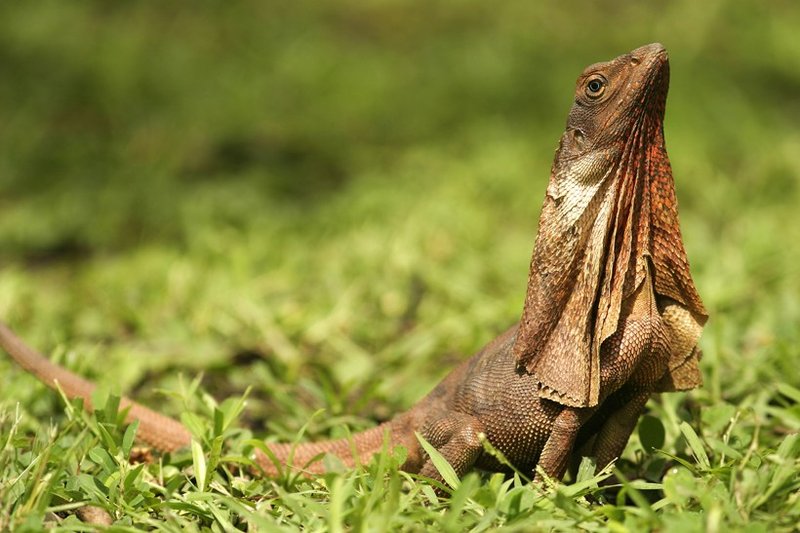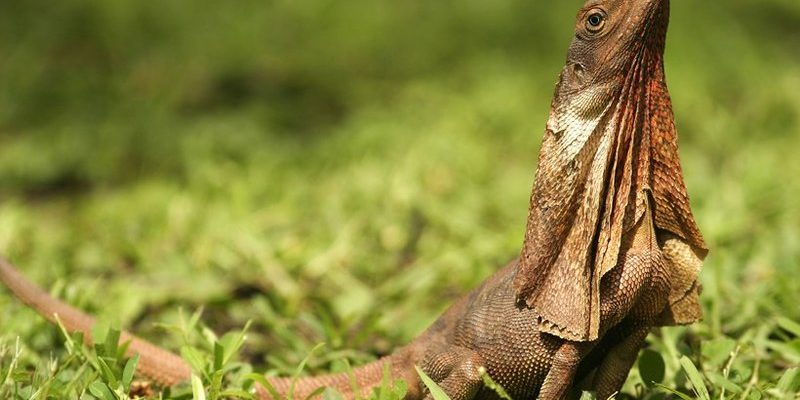
If you’ve ever seen a frilled lizard in action, you know it’s quite a sight! With its stunning neck frill and lively personality, this lizard brings a unique flair to the animal kingdom. Imagine a tiny dragon, puffing out its frills in a dramatic display—the frilled lizard embodies this image perfectly. They’re not just fascinating to look at; they also have some very interesting behaviors and a unique lifestyle that make them stand out among reptiles.
Native to the lush forests of Australia and New Guinea, these reptiles have evolved some compelling adaptations that help them survive in their natural habitats. What makes them truly special is their vibrant frills, which they display to scare off predators or attract mates. So, whether you’re a budding herpetologist or just someone with a love for cool animals, let’s dive into the world of the frilled lizard and uncover what makes these creatures so captivating.
Overview of the Frilled Lizard
The frilled lizard (Chlamydosaurus kingii) belongs to the family Agamidae, which houses a variety of colorful and engaging lizard species. These lizards are known for their distinctive frill that encircles their neck. When threatened, they can expand this frill dramatically, making them appear larger to intimidate potential predators. It’s a fascinating survival tactic that works wonders in the wild.
Frilled lizards can grow to about 3 feet in length, with the majority of that length consisting of their long tails. They typically weigh between 2 to 3 pounds. The coloration of their skin can vary from brown to greenish hues, which helps them blend into their forest surroundings. This camouflage is crucial for both hunting and evading predators. You might spot them basking on a tree branch, where they soak up sunlight, or perched quietly among the foliage, waiting for insects to swoop by.
| Common Name: | Frilled Lizard |
| Scientific Name: | Chlamydosaurus kingii |
| Size: | Up to 3 feet |
| Weight: | 2-3 pounds |
| Habitat: | Tropical rainforests |
| Diet: | Insects, small vertebrates |
| Lifespan: | Up to 10 years |
Habitat and Range
The frilled lizard primarily inhabits the tropical forests of Australia, especially in the northern regions. They can also be found in parts of New Guinea. Their preference for humid, warm environments plays a significant role in their lifestyle. These lizards are arboreal, meaning they thrive in trees where they can easily blend in with their surroundings. You’ll often find them clinging to branches or basking on tree trunks, fully utilizing their environment.
The dense foliage and warm climate provide the perfect backdrop for their daily activities—like hunting for insects and basking in the sun. The frilled lizard is also predominantly diurnal, meaning they are most active during the day. This is when they can efficiently hunt and enjoy the warmth of the sun, which is essential for their metabolism. However, their ability to camouflage with bark and leaves helps protect them from predators such as birds of prey.
Interestingly, their frills are not just for show; they also provide vital protection. If threatened, a frilled lizard can expand its frill, making it appear larger and more intimidating to potential predators. This behavior is not just a display; it’s a survival tactic that has evolved over time. So, while they often seem like the stars of their forest stage, they are also shrewd actors, playing their parts to survive in the wild.
Diet and Feeding Habits
You might be curious about what these impressive lizards eat. The diet of a frilled lizard consists mainly of insects, but they aren’t picky eaters. They also enjoy other small creatures, including spiders and small vertebrates. Their preferred hunting method is to remain perfectly still, making them look like part of the bark or leaves. When an unsuspecting insect passes by, they strike with lightning speed!
Their keen eyesight plays a critical role in their hunting success. Frilled lizards can detect movement from a distance, allowing them to zero in on their next meal. They consume their prey whole, thanks to their flexible jaws, which makes it easier to swallow larger insects. You’ll often see them hunting in the early morning or late afternoon, capitalizing on the cooler temperatures to increase their activity levels.
It’s worth noting that frilled lizards can also adapt to their food sources based on availability. In areas where insects are scarce, they may hunt for other small animals or even eat fruits occasionally. This adaptability helps them thrive in varying environmental conditions, showcasing their resilient nature as a species.
Behavior and Social Structure
When it comes to behavior, frilled lizards are quite fascinating. They are known for their unique courtship rituals and social interactions. During the mating season, males perform elaborate displays to attract females. This includes head bobbing and expanding their frills to showcase their health and genetic fitness. It’s like a dance-off but in the reptile world!
Frilled lizards are generally solitary creatures. They do enjoy a bit of social interaction during the breeding season, but they typically prefer to go about their business alone. Males can be territorial, so when two males meet, it may result in a display of dominance, where they puff up their frills and bob their heads. This intimidation tactic is often enough to deter a rival without the need for physical confrontation.
Another interesting behavior is their method of communication. Frilled lizards communicate using body language, including their frill and posture. When feeling threatened, they might hiss or make quick movements to scare off predators. This mix of visual and auditory cues plays a significant role in their survival, allowing them to convey important messages without needing to resort to aggression.
Reproduction and Lifespan
When it comes to reproduction, female frilled lizards play a vital role in the survival of the species. After a successful courtship with a male, the female lays between 7 to 20 eggs. She typically digs a burrow in sandy or loose soil to lay her eggs, ensuring they are well-protected from predators and the elements. The incubation period lasts for about two to three months, depending on environmental conditions.
Once the eggs hatch, the baby frilled lizards are on their own! They are miniature versions of their parents, fully capable of hunting for food shortly after hatching. It’s nature’s way of ensuring that they learn quickly how to survive in the wild. This independence from a young age is crucial, as the survival rate for juvenile lizards can be quite low due to predators.
As for their lifespan, frilled lizards can live up to 10 years in the wild, though in captivity, they sometimes live longer due to the absence of predators and consistent food supply. This longevity allows them to contribute to their populations over time, ensuring the continuation of their species. Isn’t it fascinating how every aspect of their life is designed for survival and adaptation?
Conservation Status
Interestingly, the conservation status of the frilled lizard is currently listed as “Least Concern” by the IUCN. This means that, for now, they are not facing immediate threats to their population levels. However, their habitats are increasingly impacted by deforestation and climate change, which could pose risks in the future. It’s a reminder that while they have a stable status now, ongoing monitoring is essential to ensure they remain safe.
Efforts to conserve their habitats are crucial, especially since frilled lizards rely on specific environments to thrive. Organizations dedicated to rainforest conservation play a significant role in protecting these creatures and their ecosystems. Supporting these initiatives can help maintain the balance of nature, benefiting many species, not just the frilled lizard.
Public awareness is also important. The more people understand the significance of these unique lizards, the more likely they are to advocate for their protection. Every little bit helps in preserving the environments they inhabit, ensuring these stunning reptiles continue to dazzle future generations.
FAQ
Are frilled lizards good pets?
Frilled lizards can make interesting pets, but they require special care. They need a specific habitat that mimics their natural environment, including proper humidity and temperature. You should also be prepared for their dietary needs, mainly consisting of insects. If you’re considering one, do your research to ensure you can meet their requirements.
How do frilled lizards behave in the wild?
In the wild, frilled lizards are cautious and observant creatures. They spend a lot of time basking in trees, waiting for insects to come by. Their ability to camouflage with their surroundings and their frill display make them effective at avoiding predators while hunting. They rely on their agility and quick reflexes to escape threats.
What is the frilled lizard’s main predator?
The main predators of frilled lizards include birds of prey and larger mammals. Their ability to blend into their surroundings helps them avoid being spotted. However, when they feel threatened, their frill display can startle and intimidate potential attackers, allowing them to escape more easily.
How do frilled lizards regulate their body temperature?
Frilled lizards are ectothermic, meaning they rely on external sources to regulate their body temperature. They bask in the sun during the day to warm up and shelter in the shade or burrows when they need to cool down. This behavior is crucial for maintaining their metabolism and energy levels.
Can frilled lizards be found outside of Australia?
While they are primarily native to Australia and parts of New Guinea, frilled lizards can be found in some exotic pet collections around the world. However, it’s important to ensure that any pet frilled lizard has been sourced ethically and not taken from the wild, as this could impact their natural populations.
What do baby frilled lizards look like?
Baby frilled lizards are quite small and often resemble miniature adults. They typically have the same coloration and features as their parents but in a smaller size. Their frills are less pronounced at first but develop as they grow older. These young lizards are independent right from the start!
What happens during the frilled lizard’s mating season?
During mating season, male frilled lizards engage in elaborate displays to attract females. This might include head bobbing and expanding their frills to showcase their health and genetics. Successful mating leads to the female laying eggs, ensuring the continuation of their species.
Do frilled lizards hibernate?
Frilled lizards do not hibernate but may become less active during cooler seasons. They rely on their basking behavior to regulate their body temperature. In their natural habitat, they adapt to seasonal changes by seeking out warmer microclimates rather than hibernating.
How fast can frilled lizards run?
Frilled lizards are quite agile and can run quickly, especially when escaping from predators. Their speed can vary based on environmental conditions, but they are generally capable of quick bursts of speed to evade danger. Their agility is one of their key survival traits.
Are frilled lizards solitary animals?
Yes, frilled lizards are generally solitary creatures. They prefer to hunt and live alone, except during the mating season when they interact with other lizards. Males can be territorial, so it’s common to see them defending their space from rivals.
What should I know before getting a frilled lizard as a pet?
Before getting a frilled lizard, it’s vital to understand their habitat needs, dietary requirements, and the commitment involved in their care. Make sure you have the right environment set up—like a terrarium with humidity controls—and be prepared for a long-term commitment, as they can live up to 10 years or longer.

